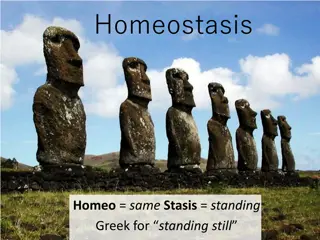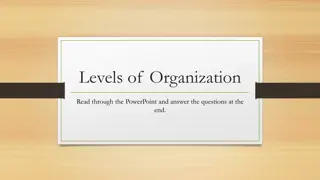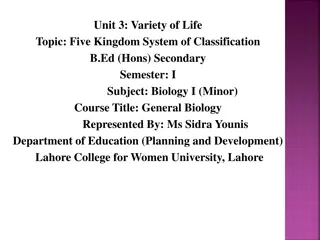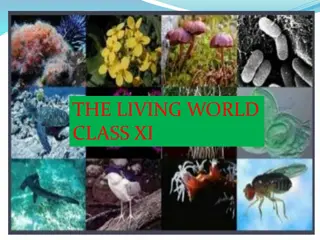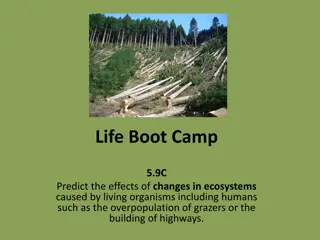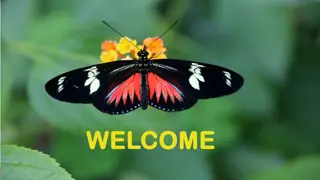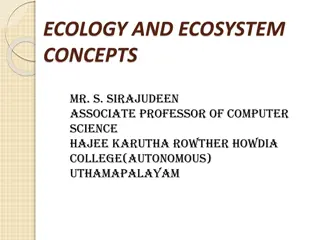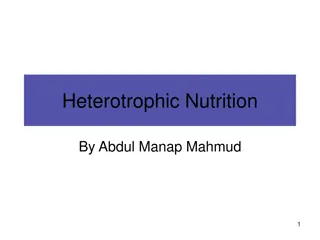Understanding the Classification of Living Organisms
Living organisms are classified into five kingdoms, each further divided into smaller groups called phyla, classes, orders, and genus. The five kingdoms are Monera, Fungi, Protista, Plantae, and Animalia. Animals are categorized into invertebrates and vertebrates, with significant agricultural importance. Protozoans, unicellular free-living organisms, play a crucial role in various ecosystems. The reproduction of protozoans, such as Babesia, can have agricultural impacts like causing Red Water Fever in cattle.
Download Presentation

Please find below an Image/Link to download the presentation.
The content on the website is provided AS IS for your information and personal use only. It may not be sold, licensed, or shared on other websites without obtaining consent from the author. Download presentation by click this link. If you encounter any issues during the download, it is possible that the publisher has removed the file from their server.
E N D
Presentation Transcript
Living organisms are classified into five kingdoms. Each kingdom is further split into smaller groups called Phyla (singular phylum) In each Phyla there are classes and then classes are subdivided into orders. Orders are then subdivided into genus. Living organisms are classified into five kingdoms. Each kingdom is further split into smaller groups called Phyla (singular phylum) In each Phyla there are classes and then classes are subdivided into orders. Orders are then subdivided into genus.
The five Kingdoms are Monera, Fungi, Protista, Plantae and Animalia.
Phylum: Chordata Class: Mammalia Order: Perissodactyla (odd toe) Family: Equidae Species: Equus caballus
Animals are classified into two main groups, Invertebrates Invertebrates (slugs and insects) do not have a backbone. Vertebrates (Humans, birds and mammals) do have a backbone. The animal kingdom is further divided into 20 phyla, of which the following are of agricultural importance: Invertebrates and Vertebrates Vertebrates.
This Kingdom includes many unicellular free- living animals called protozoans (one cell). Most of them live in water, either seawater, fresh water or soil borne water. They are nearly all microscopic. The various species of Protozoans move in a number of ways: Pseudopodia (False feet) Cilia (Small moving hairs) Tails
Reproduction of protozoans occurs by means of binary fission Amoeba is one of the most common protozoans and moves by means of pseudopodia. One of the most agriculturally important species of Protozoans is Babesia. This protozoan causes Red disease that affects 100,000 cattle a year. binary fission or mitosis. Red- -water Fever water Fever, a
Single celled (Unicellular) Microscopic in size (need microscope to see them) Spores are an important part of their lifecycle. Babesia causes redwater fever in cattle and it is transmitted by the sheep tick (Ixodes ricinus)
A tick sucks blood from an infected cow. The blood contains Babesia sporozoites. Spores form gametes that form a zygote in sexual reproduction. Many spores are formed in the tick by asexual reproduction. The tick then bites a cow to suck blood and it transmits the spores into the cows bloodstream. The spores form sporozoites that enter the red blood cells of the cow and reproduce rapidly bursting red blood cells.
The Haemoglobin that is released from the red blood cells is passed in the urine of the cow, giving the name red-water fever. Haemoglobin- is a red pigment found in red blood cells. Haemoglobin is based on a molecule of iron and can join with oxygen in areas of high oxygen in the lungs. The function of red blood cells is to transport oxygen. Anaemia - is a lack of haemogobin (or red blood cells) (Iron injection prevents anaemia)
Symptoms appear in animals 10 to 20 days after infection. Animals pass red urine due to the presence of haemoglobin produced by the rupture of red blood cells. Animals have increased pulse rate. Animals get diarrhoea followed by constipation. Page 66 Draw Lifecycle of Babesia. 1=Tick 2=Spores 3=Spores 4= Tick 5=Cow
Flatworms Have distinctive front and rear end. Do not have an internal body cavity. Have 3 cell layers (triploblastic) Flattened dorsoventrally. Hermaphrodites Hermaphrodites both male and female reproductive organs and can self fertilize themselves. Hermaphrodites - - organisms that contain
Tapeworms Flat, elongated bodies. Live in the intestine of animals. Endoparasites Endoparasites inside the animals body. Attach themselves to the intestinal wall with a scolex - series of hooks. Have no digestive system. Absorbs nutrients from hosts gut. Controlled with regular dosing using anti- helminths. Endoparasites - - these are parasites that live
Liverfluke Liverfluke are parasites of Sheep and cattle. Flat, leaf shaped bodies. Have an oral sucker and ventral sucker which allows them to attach to their host. Found in Liver and Bile ducts of sheep, cattle, pigs and goats. Hermaphrodites Cuticle - an outer covering on the liverfluke which protects the fluke from the hosts defences.
Liverfluke lie in the ducts of the Liver in cattle and sheep. 1.The eggs produced by the fluke pass down the bile duct of the host (sheep or cattle) and the host in the faeces. The sheep or cattle are the Primary Host . 2.The eggs hatch in about two weeks in water in the ground into a larva called a miracidium. 3. The larva enters the foot of a mudsnail using enzymes secreted by a penetration gland. The snail can live both on land and in water.
4. The snail is the secondary host of the liverfluke. 5. Once in the snail the miracidium undergoes a number of larval stages which produce large numbers of infective flukes by asexual reproduction. 6. The first stage in the lifecycle of the fluke in the snail is called the redia. 7. The rediae produce the cercaria. The cercaria is shaped like a minature frog tadpole with a tail for swimming.
8. The cercaria leaves the snail and forms a cyst on waterside vegetation. Cysts can survive long periods of drying. 9. Once eaten by the final host (sheep, cattle) the young fluke is released. It bores into the hosts abdominal cavity and enters the liver from there. 10. Liverfluke feed on blood and liver cells and have a specialised outer covering called a cuticle which protects them from the hosts defences.
Liverfluke causes huge economic losses in agriculture. The liver of the primary host (sheep or cattle) will be damaged. A damaged liver can result in liver-rot and the build up of fluid around the body. The reduction in bile has a bad effect on digestion and results in poor digestion. All of the above results in: Low milk yields in sheep and cattle. Poor quality dry wool in sheep. Animals fail to gain weight. Fertility in sheep and cattle is reduced.
1.Drainage of Wet Land: this reduces the number of snails and the miracidia die. 2. Biological Control: ducks and geese are put out on wet land and they eat the snails. This prevents the miracidia from developing. 3. Fencing off wet pastures: this prevents the cercaria from reaching cattle or sheep. 4. Spraying mollusicides: these sprays kill molluscs i.e. the mudsnail and therefore the miracidia die.
5. Filling in ponds and elevated drinking troughs: both these measures will help to remove mudsnails and the miracidia will die. 6. Liming the Land: this increases the ph of the soil above 7.5 and the fertilised eggs cannot hatch. 7. Dosing: with an anti-helminth e.g. Fasinex this helps to prevent the spread of the disease and kills adult flukes.
Round in Cross-section Seperate sexes ( male and female seperate) Male is usually smaller than the female and has a coiled tail. Body cavity is known as a pseudocoelome. Body is covered in a cuticle.
Eelworms are free-living or live on plants. Eelworms attack stems and roots of crops such as potatoes, onions & strawberries. Potato eelworm (Heterodera) is the most important in Irish agriculture. Eelworms feed on the roots of the potato plants which causes stunted growth and small tubers. Crop Rotation - prevents the build up of eelworms.
Roundworms are cyclindrical in shape, tapered at both ends and vary in length from being microscopic to 20inches. Roundworms have a complete gut. Roundworms have a one-way digestive system with a gut that begins with a mouth and ends with an anus. Roundworms are able to digest food. Roundworms have no blood or heart. Roundworms of importance include; lungworms, hookworms and hairworms.
Segmented body. Round in Cross section. Have a Circulatory system Has a clitellum (used in reproduction) Body cavity known as a coelome. Bristles on body known as chatae. Hermaphrodites: this means that they have male and female and they can reproduce themselves. Clitellum: is a ring shape on the earthworms body and it is lighter in colour than the rest of the body. It secretes a fluid allowing for the formation of a cocoon for the Earthworms eggs.
Peristalsis: earthworms move by perstalsis, where the body contracts and expands shortening and lengthening as it expands. Chatae: allow the earthworm to anchor its body as it moves along. Advantages of Earthworms in The Soil 1.Improve soil aeration by their burrowing in the soil. 2.Improve soil drainage by their burrowing action. 3. Mix soil layers by bringing organic matter to deeper levels through burrowing.
4. Improve soil fertility as they convert organic matter e.g. Leaf litter into humus. 5. Add nutrients worm casts created by excretion are high in nitrogen, phosphates and potash due to the breakdown of organic and mineral matter by the earthworms digestive system. This leads to higher nutrients in the soil. 6. Add Humus: when they die and decay.
Conditions needed for Earthworms 1.pH between 6 and 8 2.Moist, but not waterlogged soil conditions. 3. Soil temperature of greater than 10degrees celsius. 4. Organic matter present. Vermiculture A particular type of worm called the tiger worm is especially adapted to breaking down organic matter on a small scale. Organic waste can be fed to these worms which are kept in a wormery producing a form of compost.
Soft bodied animals. Foot - secretes mucus to aid movement. Radula rasping tongue for cutting vegetation such as shoots, leaves. Have a coelom The main difference between a slug and a snail is that a snail has a shell. Slugs and snails are pests in agriculture as they eat leaves, plant shoots, flowers and ripened fruit. The watersnail in very important as it is the secondary host in the lifecycle of the Liverfluke. Biological Control: Slugs and snails can be controlled biologically by introducing ducks and geese which will eat the slugs and snails. Mollusicides: chemical sprays called mollusicides will also kill slugs and snails.
Includes all insects and arachnids (spiders) All are invertebrates - they do not have a backbone. Have segmented bodies. Have jointed limbs (legs, wings etc) Have an exoskeleton protects their body. They shed their exoskeleton regularly as they mature allowing them to grow and produce another exoskeleton. This shedding or moulting is called ecdysis. There are two main classes - class Arachnida and class Insecta. made of chitin this
Arachnids include Spiders, mites and Ticks. Arachnids have eight legs in four pairs, and two main body segments called the cephalothorax and abdomen. Arachnids do not have antennae or wings. Most Arachnids in agriculture are ectoparasites this means that they live outside the hosts body on the skin or the exterior of the body.
Red Spider Mite: is a plant parasite that sucks the sap out of fruit and vegetables including strawberries, apples, potatoes etc They can be controlled by using pesticides which are chemicals that kill them or by introducing a predator mite which also eats them. Ticks: live on the skin of cattle and sheep sucking their blood. The most important tick in agriculture is the sheep tick which transmits Babesia and Babesia causes redwater fever in cattle. Mange mite: female mange mite burrows into the skin to lay their eggs and when the larvae hatch further burrowing occurs. The burrowing action causes itching in the animal and if left untreated can lead to open wounds and sores. Dung beetle: has appendages, legs and a head. Important in agriculture as it: 1.Eliminates dungpats 2.Decomposes organic matter 3.Recycles nutrients 4.Improves Grazing
Have segmented bodies. Bodies divided into three parts: head, thorax, and abdomen. Have six legs, antennae and compound eyes (P.71 Draw diagram) They normally have two pairs of wings attached to the thorax. They undergo a process of development called Metamorphosis growth stages. There are two types of Metamorphosis: 1.Incomplete Metamorphosis 2.Complete Metamorphosis
Incomplete Metamorphosis: Egg The immature insect undergoes a series of moults, shedding its exoskeleton at each stage to allow for growth and development. Nymphs are insects that are going through incomplete metamorphosis and they look exactly like their parent only they are smaller. Wings do not appear until they reach adulthood. Aphids (Greenflies), Dragonflies and damselflies under incomplete metamorphosis. Aphids (Greenflies) do a lot of damage to plants as they suck sap out of plants and they transmit virus diseases. Aphids can be controlled by spraying aphicide sprays or by using Biological control: Ladybird is introduced and they eat the greenfly. Nymph Adult
Complete Metamorphosis: Egg Each stage in complete metamorphosis is physically different to the previous stage. The larval stage is worm like in appearance and a feeding stage in the lifecycle. Larva develops into a pupa which is often protected by a cocoon. In the pupa stage there is very little movement. Adult emerges after the pupa stage. Butterflies are an example of an insect that undergo complete metamorphosis(P. 72Diagram) Other insects that undergo complete metamorphosis are: 1.Cranefly - larva stage is Leatherjacket. Leatherjackets eat the roots of grassses, cereals, vegetables and strawberries. 2.Clickbeetle: larva stage is the wireworm. Wireworms feed on the roots of grasses and damage potato tubers sown after grass. Pupa Larva Adult
Vertebrates: all members of the phylum chordata are vertebrates, this means that they have a backbone. There are two classes of importance in Phylum Chordata: 1. Class Aves: all birds, birds have feathers, have a beak with no teeth, lay eggs, are warm blooded (endothermic) animals. Birds do no have a bladder, so faeces and uric acid are combined and excreted together as a semi-solid waste. In agriculture birds such as chickens, ducks, geese and turkeys are reared for meat and eggs. A by product are feathers used for clothing and bedding.
2. Class Mammalia: a wide variety of animals are in this group, cattle, sheep, pigs, horses, donkeys, humans, etc. All mammals have hair, mammary glands in the female that produce milk, sweat glands and produce live young. Most mammals of importance in agriculture are in the order ungulata and have hooves. These include cattle, sheep, pigs, horses, donkeys and goats. Herbivores: these are animals that eat plants only e.g. Sheep, cattle, horses. Omnivores: these are animals that eat plant and animal material e.g. Pigs and Humans. Carnivores: these are animals that feed on the flesh of other animals e.g. Lions.
Sheep - produce meat, milk, cheese, wool. Merino sheep in Australia are kept for their wool mainly. Lamb is the most sought after meat and is most expensive at Easter. Mutton is meat from sheep greater than one year old. Cattle - produce beef, milk, cheese, hides are used for many products e.g. Footballs. Pigs - used for meat, ham, pork etc
Ticks - Babesia - Greenfly - Spider - Liverfluke - Earthworm - Tapeworms - Roundworms - Eelworms - Slugs - Snails - -Centipede -Minks -Dungbeetle -Lungworms -Badgers -Crows -Foxes -Mange Mite -Clickbeetle -Cranefly -Caterpillar
Pick 15 of the non-producing animals of importance in agriculture and get a picture of them. In a scrapbook on one side of a page put the picture and on the other side put the information about the animal which must include - Phylum - Lifecycle (include a diagram) - Damage the do - Where they can be found - How they can be controlled - Can they be controlled biologically or not - what sprays can be used to control them - any other relevant information you understand.


